2. 中国水产科学研究院黄海水产研究所 农业农村部海洋渔业与可持续发展重点实验室 山东 青岛 266071;
3. 崂山实验室海洋渔业科学与食物产出过程功能实验室 山东 青岛 266071
2. Key Laboratory of Marine Fisheries and Sustainable Development, Ministry of Agriculture and Rural Affairs, Yellow Sea Fisheries Research Institute, Chinese Academy of Fishery Sciences, Qingdao 266071, China;
3. Laboratory for Marine Fisheries Science and Food Production Processes, Laoshan Laboratory, Qingdao 266071, China
浮游动物在水生生态系统营养结构中所占的“中介”地位,使其在连接初级生产者和高营养水平方面发挥着关键作用(Steinberg et al, 2017)。同时,作为海洋食物链的重要组成部分,其时空分布的变化可能会影响整个海洋生态系统,使得浮游生物成为水生生态系统一般功能条件的重要指标(Gagneten et al, 2009; 郭永坚等, 2015)。浮游动物群落结构与环境因素的变化密切相关,对气候变化和人类活动高度敏感(Li C et al, 2022)。浮游动物群落的生活史和组成受到特定生态系统中存在的物理、化学和生物特性的影响和塑造。一般来说,这些因素在沿海地区的波动比在远洋地区更为明显。在众多的海洋栖息地中,近海海湾与人类社会关系最为密切,拥有丰富的渔业资源且分布着密集的水产养殖产业,这在很大程度上与浮游动物群落有关(Ke et al, 2014)。物理参数(如温盐)和化学参数(如氮磷)直接或间接地影响着沿海浮游动物的丰度和群落结构。因此,研究沿海海域浮游动物群落动态变化,对于提高我们对沿海海洋生态系统功能的认识,特别是初级生产者向更高营养级的能量转移具有重要意义(聂丹丹等, 2009)。
靖海湾松江鲈鱼(Trachidermus fasciatus Heckel)国家级水产种质资源保护区是黄海南部一个典型的半封闭海湾,位于山东省威海市文登区境内,总面积约818.89 hm2,保护区的保护对象是我国二类保护动物松江鲈鱼(崔毅等, 2013)。靖海湾是近海海域,大陆架边缘的近海海域是海陆交汇、物质和能量剧烈碰撞的区域,受到强大的大陆–海洋相互作用的影响,导致其拥有复杂的物理和化学性质(McLusky et al, 2004)。同时,靖海湾附近有许多水产养殖池、工厂和农田,人类活动产生的大量氮、磷污染物通过地表径流(如青龙江)进入沿海水域,导致富营养化,从而影响靖海湾海洋生态系统(Li et al, 2015)。因此,这一地区的物理和化学因素受到近海海域和周围陆基入海污水源的极大影响(滕瑶等, 2018)。
此前,夏斌等(2010)研究表明,2008年6月靖海湾水产种质资源保护区表层海水达到富营养化水平,且有机污染严重,活性磷酸盐是主要的污染物。2011年靖海湾水产种质资源保护区属于磷限制潜在性富营养水平,2012年属中度富营养水平(崔毅等, 2013)。毕炜家等(2015)研究靖海湾浮游生物及大型底栖动物的多样性,发现靖海湾海域生物群落结构稳定,环境质量良好。已往的研究局限于对靖海湾松江鲈鱼保护区环境质量或生物群落的单一研究,而对靖海湾海域浮游动物群落变化与环境因子的关系进行分析评价的研究尚无相关报道。本研究基于2021―2022年春季(5月)和夏季(8月)对靖海湾松江鲈鱼国家级水产种质资源保护区表层海水中部分环境因子和生物数据的调查,利用最新数据分析影响靖海湾浮游动物种类组成、丰度、生物量和多样性的主要环境因素。研究结果将有利于后续研究靖海湾生态系统和浮游动物群落动态的长期变化,有助于科学评价和管理靖海湾生态环境。
1 材料与方法 1.1 样品的采集与分析本研究包含位于中国靖海湾(37°00′00″~ 37°01'12″N,122°11'24″~122°12'00″E)的4次海洋调查数据,涵盖9个站点,采用相同的采样策略和分析(图 1)。这4次调查分别发生在2021年和2022年的5月和8月,分别代表 2个年度的春季和夏季,2021年度缺少B8号站位的浮游动物数据。调查海域水深均小于5 m,因此,只取表层水样。使用YSI多参数水质仪(ProDSS, 美国)进行现场温度、盐度、溶解氧和pH的测量。浮游动物样品按照《海洋调查规范第6部分:海洋生物调查》(GB/T 12763.6-2007)采用浅水I型浮游生物网垂直采集。为了测量过滤海水的体积,I型网配备一个校准的流量计(Hydrobios)。随后将采集的浮游动物网样品装入500 mL PE瓶中,用5%甲醛溶液(终浓度)固定,运到实验室进行进一步分析。在表层(~2 m)使用10 L的Niskin瓶采集海水样品。测定营养盐浓度的海水样品通过醋酸纤维素膜过滤器(0.45 μm; 47 mm),储存在150 mL的PE小瓶中,随后静置于–20 ℃冰箱中至测定。采集250 mL海水样品用于化学需氧量(COD)的测定,静置在–20 ℃冰箱中冷冻并尽快分析。为了提取和定量叶绿素a (Chl a),将500 mL海水样品在低真空压力(< 0.04 MPa)下使用Whatman GF/F过滤器(25 mm)过滤,然后立即在–20 ℃冰箱中冷冻,直到分析。以上所有的生物和环境参数均利用Niskin瓶中收集的相同水样测量。
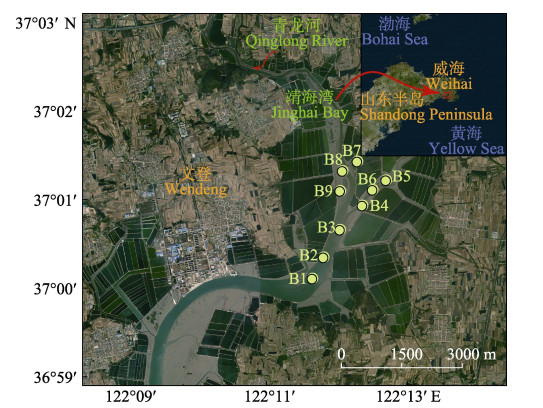
|
图 1 靖海湾研究区域和采样站(B1~B9) Fig.1 Study area and sampling stations (B1~B9) in the Jinghai Bay |
在对浮游动物样本进行显微镜分析之前,挑选大型浮游动物(如水母)并计数。随后,将剩余浮游动物样本至少总体积的1%放置在浮游生物计数架中,在40~100倍放大倍率的Motic AE2000倒置显微镜下鉴定和定量。此外,浮游动物生物量基于湿重法采用0.01 g的天平称重(Alcaraz et al, 2003)。
根据经典比色法,采用Technicon AA3自动分析仪(Bran+Luebbe, 德国)分析和测定营养素浓度,包括铵(NH4+-N)、硝酸盐(NO3–-N)、亚硝酸盐(NO2–-N)和磷酸盐(PO43–-P)(Crouch et al, 1967; Verdouw et al, 1978)。溶解无机氮(DIN)的浓度为NH4+-N、NO3–-N和NO2–-N的浓度之和。溶解无机磷(DIP)的浓度即为PO43–-P的浓度值。COD在实验室中使用碱性高锰酸钾法测定。
在5 mL的90%的丙酮(4 ℃, 黑暗条件下24 h)中提取叶绿素a。拆除过滤器后,按照Welschmeyer (1994)的荧光测定方法,在CE Turner设计的荧光计上测定叶绿素a的浓度。本研究使用的所有化学品均为分析级。
1.3 数据分析为了描述浮游动物群落的组成和结构,分别按公式(1)、(2)和(3)计算物种香农–威纳(Shannon-Wiener)多样性指数(H′)、Pielou均匀度指数(J)和优势度指数(Y) (Wei et al, 2023)。
| $ H\prime = - \sum\limits_{i = 1}^s {{P_i}} {\log _2}{P_i} $ | (1) |
| $ J = \frac{{H\prime }}{{{{\log }_2}S}} $ | (2) |
| $ Y = \frac{{{n_i}}}{N}{f_i} $ | (3) |
式中,S为每个样本中浮游动物种类总数,N为所有样本中物种的总丰度,ni为i种物种的个体数,Pi为i种物种的丰度,fi为i种物种在每个样本中出现的频率,以Y≥0.02作为优势种(徐东会等, 2016)。
水质富营养化指数EI由公式(4)计算,1≤EI≤3为轻度富营养化,3 < EI≤9为中度富营养化,EI > 9为重度富营养化(Zhu et al, 2020)。
| $ {\text{EI}} = \frac{{{C_{{\text{COD}}}} \times {C_{{\text{DIN}}}} \times {C_{{\text{DIP}}}}}}{{4500}} \times {10^{\text{6}}} $ | (4) |
式中,EI为富营养化指数,CCOD为实测化学需氧量浓度(mg/L),CDIN为实测无机氮浓度(mg/L),CDIP为实测磷酸盐浓度(mg/L)。
所有值以平均值±标准差(Mean±SD)表示。使用ArcMap 10.8构建站位分布图。浮游动物优势种与环境因子间的关系采用冗余分析(redundancy analysis, RDA),分析过程使用Canoco 5.1按照国际通用标准完成(Zheng et al, 2022)。箱线图和线性回归模型使用Origin 2022生成。使用R统计软件的“pheatmap”(v4.0.3)制作Pearson相关性热图。采用R包“vegan”(v 2.5-7)进行主坐标分析(PCoA)。
2 结果 2.1 水文特征图 2和表 1显示了2021―2022年环境因素的可变性,年际和季节性变化的气候条件及沿海径流(如青龙河的流入)对靖海湾水文特征影响较大。研究区域平均气温为17.68~26.92 ℃,存在年际和季节变化特征,夏季显著高于春季(图 2a)。同时,2021年平均气温略高于2022年(表 1)。平均盐度的变化(范围为12.06~34.37)通常受到陆地输入和海水入侵所影响,季节变化较大,春季显著高于夏季(图 2b)。同时,在所监测海域年际变化特征也十分显著,2021年平均盐度显著高于2022年(表 1)。溶解氧平均含量在4.73~6.52 mg/L之间,无明显的年际和季节变化特征(图 2d)。2021―2022年平均pH值在7.76~7.84范围内变化,无显著的季节变化特征(图 2c);年际变化上,2021―2022年呈下降趋势,表明水体存在酸化潜力。

|
图 2 2021―2022年春夏季靖海湾各项环境参数的变化 Fig.2 Changes in various environmental parameters of Jinghai Bay during the spring and summer seasons of 2021–2022 |
|
|
表 1 靖海湾海水的季节水文特征 Tab.1 Seasonal hydrological characteristics of the sea water in Jinghai Bay |
COD的平均含量在0.72~4.72 mg/L之间,具有明显的年际变化特征,2021年平均COD显著低于2022年,在2022年夏季出现了极高值(图 2e),表明靖海湾水体的有机负荷提高。叶绿素a的平均含量在3.66~23.77 μg/L之间,具有明显的年际变化特征,2021年平均叶绿素a显著高于2022年,在2022年夏季出现极低值(图 2e)。该区域的营养物质浓度(无机氮和磷酸盐)存在相同的年际和季节变化特征,即春季低于夏季,2021年低于2022年,无机氮的平均含量在162.93~909.25 μg/L之间,磷酸盐含量在76.82~224.72 μg/L之间(表 1)。
2.2 富营养化指数图 3a显示,靖海湾海域2021―2022年富营养化程度剧烈上升。2021年春夏两季平均富营养化指数(EI)均大于3,但小于9,属于中等富营养化。而2022年春夏两季平均EI值均超过9,达到重度富营养化。4个航次EI的平面分布呈相似的分布情况(图 3b~e),在靠近研究区域北部的站位观察到较高的数值,说明河流输入(如青龙河)是靖海湾海域富营养化污染的主要来源。
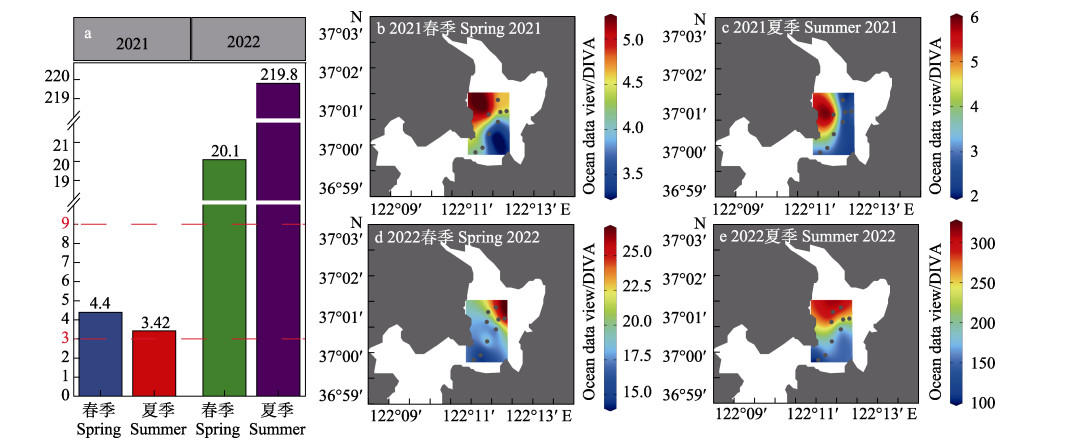
|
图 3 2021―2022年富营养化指数(EI)变化趋势(a)和平面分布(b~e) Fig.3 Trends (a) and (b–e) distribution of eutrophication index (EI) from 2021 to 2022 |
2021年春季至2022年春季,浮游动物丰度和生物量大致呈上升趋势,2022年夏季丰度出现显著的下降(图 4a)(平均丰度为54.07个/m3)。2021年春季至2022年春季,生物量呈现相同的变化趋势(图 4b)。但值得注意的是,与2022年夏季丰度的低谷相比,其生物量并未大幅下降,这可能是导致浮游动物生物量与丰度之间无显著相关关系的原因之一(R2=0.09, P > 0.05) (图 4c)。

|
图 4 2021―2022年靖海湾浮游动物的丰度年际和季节变化(a)、生物量年际和季节变化(b)及丰度与生物量的线性关系(c) Fig.4 Inter-annual and seasonal variations of zooplankton abundance (a), inter-annual and seasonal variations of zooplankton biomass (b), and linear relationship between abundance and biomass (c) in Jinghai Bay from 2021 to 2022 |
靖海湾2021—2022年度4个航次共鉴定出浮游动物10类47种,桡足类最多(16种),其次为浮游幼虫(15种),刺胞动物7种,端足目和枝角类各2种,毛颚动物、十足目、涟虫目、被囊动物和栉水母动物各1种。其中,2021年春季共鉴定出4个类群17种,夏季共鉴定出5个类群23种;2022年春季共鉴定出5个类群25种,夏季共鉴定出7个类群22种。4个航次中桡足类和浮游幼虫种类数占比最高。浮游动物种类组成存在一定的季节变化,从春季到夏季桡足类种类数占比逐渐降低,浮游幼虫种类数占比逐渐升高(表 2)。
|
|
表 2 靖海湾浮游动物种群的组成 Tab.2 Composition of zooplankton population in Jinghai Bay |
利用PCoA评估靖海湾海域浮游动物群落在两年中春季和夏季的变化(图 5a)。前2个PCs解释了浮游动物群落总变化的57.87%。PERMANOVA结果显示,前3个航次部分站点浮游动物群落基本相似。值得注意的是,2022年夏季浮游动物群落与前3个航次有显著区别,2022年夏季浮游动物群落可能发生了显著的变化。
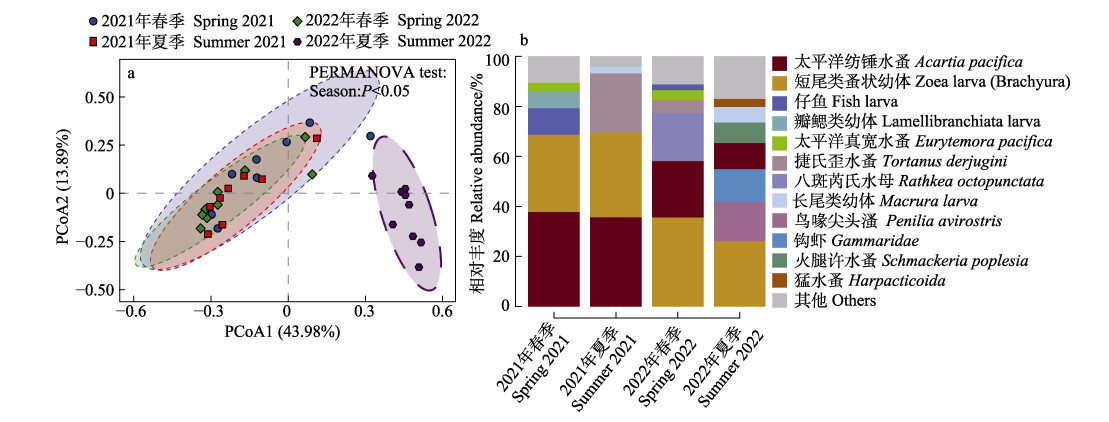
|
图 5 靖海湾不同航次浮游动物群落的PCoA分析(a)和靖海湾浮游动物优势物种相对丰度(b) Fig.5 PCoA analysis for the zooplankton communities among different voyages in the Jinghai Bay (a), and the relative abundance of dominant species of zooplankton in the Jinghai Bay (b) |
本研究浮游动物选取优势度(Y)≥0.02的物种为优势种(表 3)。2021年春季有优势种5种,分别为太平洋纺锤水蚤(Acartia pacifica)、短尾类溞状幼体、仔鱼、瓣鳃类幼体和太平洋真宽水蚤(Eurytemora pacifica)。2021年夏季有优势种4种,分别为太平洋纺锤水蚤、短尾类溞状幼体、捷氏歪水蚤(Tortanus derjugini)和长尾类幼体。2022年春季有优势种6种,分别为短尾类溞状幼体、太平洋纺锤水蚤、八斑芮氏水母(Rathkea octopunctata)、捷氏歪水蚤、太平洋真宽水蚤和仔鱼。2022年夏季有优势种7种,分别为短尾类溞状幼体、鸟喙尖头溞(Penilia avirostris)、钩虾、太平洋纺锤水蚤、火腿许水蚤(Schmackeria poplesia)、长尾类幼体和猛水蚤(Harpacticoida)。其中,太平洋纺锤水蚤和短尾类溞状幼体在4个航次均为优势种。此外,2021―2022年太平洋纺锤水蚤优势度呈持续降低的趋势(图 5b);2022年春季和夏季短尾类溞状幼体成为该海域第一优势种,但在夏季短尾类溞状幼体相对丰度和优势度均出现下降。在本研究中,2022年的优势种数量多于2021年,且在2022年夏季优势物种数量达到最大(图 5b)。
|
|
表 3 靖海湾的优势浮游动物物种(x: 平均丰度, 个/m3; Y: 优势指数) Tab.3 Dominant plankton species in Jinghai Bay (x: average abundance, ind./m3; Y: dominant index) |
不同的生物多样性指数以不同的方式表达浮游动物群落或组合的多样性,但评价群落多样性的最佳方法是将这些指数组合使用。总体而言,靖海湾海域浮游动物群落多样性指数(H′)和均匀度指数(J)的年际和季节变化趋势相似(图 6和表 4)。从季节变化上看,2021年春季多样性指数(H′)和均匀度指数(J)都高于夏季。2022年呈相反的趋势,其多样性指数(H′)和均匀度指数(J)夏季高于春季。从年际变化上看,2022年多样性指数(H′)和均匀度指数(J)都高于2021年。从总的变化趋势上看,从2021年到2022年,靖海湾海域浮游动物生物多样性逐渐提升。

|
图 6 2021―2022年靖海湾浮游动物多样性指数(H′)和均匀度指数(J)变化 Fig.6 Zooplankton Shannon-Wiener diversity index (H′) and Zooplankton Pielou´s evenness index (J) in Jinghai Bay from 2021 to 2022 |
|
|
表 4 靖海湾浮游动物群落的多样性指数(H′)和均匀度指数(J)的变化 Tab.4 Changes in Shannon-Wiener diversity index (H′) and Pielou´s evenness index (J) of zooplankton community in Jinghai Bay |
进行冗余分析(RDA),以确定哪些环境变量影响靖海湾优势物种的变化,并了解控制靖海湾优势物种变化的决定因素(图 7)。4次调查均出现的优势物种太平洋纺锤水蚤和短尾类溞状幼体在2年的春夏季均与富营养化指数(EI)呈负相关,表明富营养化水平的提升可能是太平洋纺锤水蚤和短尾类溞状幼体优势度和丰度减少的原因(图 7)。而在2022年夏季新出现的优势物种鸟喙尖头溞、钩虾和火腿许水蚤与EI、磷酸盐和COD呈正相关,与盐度呈负相关,表明随着富营养化的增长和夏季盐度的降低,群落发生了变化,出现了一些对富营养化较为适应的低盐物种。此外,仅在春季出现的太平洋真宽水蚤在2年的春季里均与盐度呈正相关(图 7a、c)。
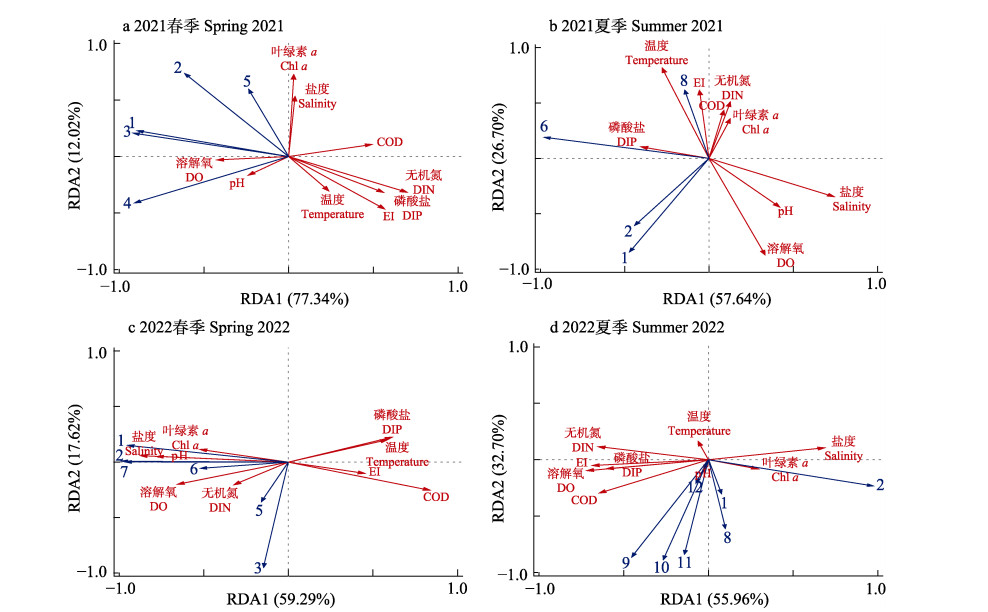
|
图 7 靖海湾浮游动物优势种与环境变量的冗余度分析(RDA) Fig.7 Redundancy Analysis (RDA) of dominant species of zooplankton and environmental variables in Jinghai Bay 1:太平洋纺锤水蚤Acartia pacifica;2:短尾类溞状幼体Zoea larva (Brachyura);3:仔鱼Fish larva;4:瓣鳃类幼体Lamellibranchiata larva;5:太平洋真宽水蚤Eurytemora pacifica;6:捷氏歪水蚤Tortanus derjugini;7:八斑芮氏水母Rathkea octopunctata;8:长尾类幼体Macrura larva;9:鸟喙尖头溞Penilia avirostris;10:钩虾Gammaridae;11:火腿许水蚤Schmackeria poplesia;12:猛水蚤Harpacticoida |
利用Pearson相关分析评估了环境变量与浮游动物丰度、生物量和多样性的潜在影响(图 8),发现富营养化指数(EI)与丰度在4个航次均呈负相关,尤其2021年春季和2021年春季,分别呈显著极负相关(P < 0.01)(图 8a)和显著负相关(P < 0.05) (图 8c)。2021年春季,丰度与COD及磷酸盐呈显著负相关(P < 0.05)。在2022年春季,丰度和COD呈极显著负相关(P < 0.01),表明富营养化指标对靖海湾浮游动物丰度影响较大。富营养化相关指标和生物量的相关性并不显著,与其他3次调查不同,富营养化相关指标在2022年夏季与生物量呈正相关。除了2022年春季,在其他3次调查中,富营养化指标和多样性相关指数均有显著相关性。在2021年春季,富营养化指数(EI)和磷酸盐与均匀度指数(J)呈极显著正相关(P < 0.01)。在2021年夏季,富营养化指数(EI)和多样性指数(H′)呈极显著负相关(P < 0.01)。在2022年夏季,EI、COD和无机氮均与多样性指数(H′)呈极显著正相关(P < 0.01),磷酸盐与多样性指数(H′)呈显著正相关(P < 0.05),EI、无机氮和磷酸盐呈与均匀度指数(J)呈显著正相关(P < 0.05)。富营养化指标和多样性相关指数的显著相关性(P < 0.05),表明靖海湾浮游动物群落结构对富营养化变化较为敏感。此外,盐度是另一项重要的环境变量。在春季,盐度与丰度和生物量呈正相关(图 8a、c),尤其在2022年春季,盐度与丰度呈极显著的正相关(P < 0.01)。而在夏季,盐度与丰度和生物量呈负相关(图 8b、d)。盐度与丰度和生物量的相关性的季节变化,可能受到冲淡水的影响。在2022年夏季,盐度与多样性指数(H′)呈显著负相关(P < 0.05),与均匀度指数(J)呈极显著负相关(P < 0.01)。表明盐度对浮游动物群落结构也有着一定的影响。溶解氧仅在2021年春季对丰度有极显著影响(P < 0.01),在后续调查中,溶解氧与群落参数并没有显著的相关性。值得注意的是,2个年度浮游动物和水温、pH及叶绿素a之间没有显著的相关关系,这表明水温、pH及叶绿素a的季节变化似乎对靖海湾浮游动物没有什么控制作用。这些结果表明,富营养化可能是影响靖海湾海域浮游动物群落动态的关键因素,而盐度是控制浮游动物季节变化的重要因子。
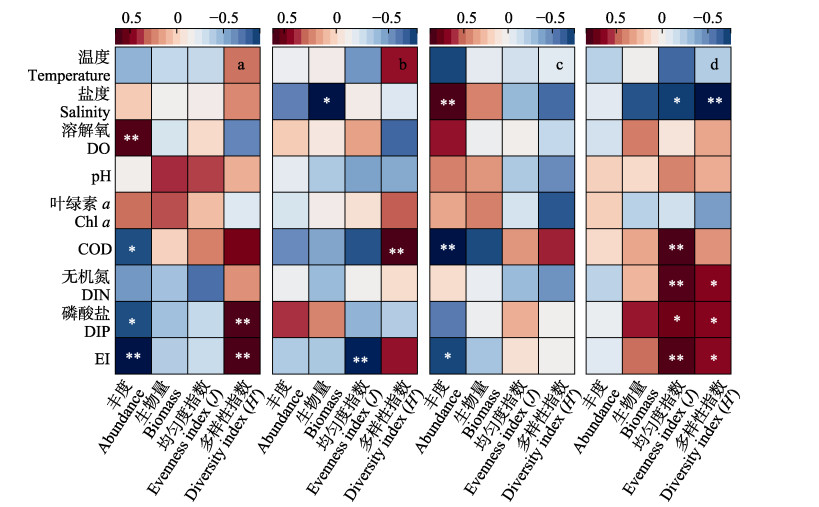
|
图 8 靖海湾浮游动物丰度、生物量和多样性指数与环境变量之间的Pearson相关分析 Fig.8 Pearson correlation analysis between the abundance, biomass, and diversity index of zooplankton and environmental variables in Jinghai Bay a:2021年春季;b:2021年夏季;c:2022年春季;d:2022年夏季。**为P < 0.01;*为P < 0.05。 a: Spring 2021; b: Summer 2021; c: Spring 2022; d: Summer 2022. ** is P < 0.01; * is P < 0.05. |
浮游动物的种群结构变化受到温盐、营养物质、水团运动、潮汐、台风等多种因素的影响,是多种环境因子综合效应的结果。传统上,包括水文过程、温度和盐度在内的自然变量通常被认为是群落结构的主要决定因素,而包括污染在内的其他变量则不太重要(Drira et al, 2014)。在公海中,洋流和水温等自然变量可能在浮游动物结构的形成中起主要作用(Hays et al, 2005)。然而,在靖海湾这种半开放近岸海域,特有的地理特征可能会导致富营养化的影响更显著。
本研究显示,靖海湾海域富营养化严重,尤其是在2022年(图 2a)。富营养化已被公认为近岸海域最重要的环境问题之一,靖海湾海域也长期受到富营养化的影响(崔毅等, 2013)。在很多沿海海域,富营养化都是影响浮游动物群落变化的关键因素,例如,Sun等(2016)通过多元统计分析表明,富营养化条件是影响乐清湾浮游动物群落空间结构的主要因素。在浮游动物群落中,优势种的动态往往能决定浮游动物群落结构的变化。在本研究的4个航次中,太平洋纺锤水蚤和短尾类溞状幼体均为优势种(图 5b)。RDA相关性分析显示(图 7),短尾类溞状幼体在4次调查中均与富营养化指数(EI)呈负相关,在富营养化程度剧烈上升的2022年夏季,短尾类溞状幼体丰度和优势度都随之下降(图 5b)。此前的研究表明,短尾类溞状幼体是一种虾蟹类幼体,密集分布于近岸水域,其近岸栖息的特性使其种群数量易受到环境富营养化变化的干扰(刘爱英等, 2012)。桡足类在沿海海域浮游动物群落中一直占主导地位(Chang et al, 2010; Liu et al, 2012),它们通常被认为对不良水质相对敏感(Uriarte et al, 2005)。富营养化可能通过浮游植物直接提供更多食物或通过复杂的微生物食物循环间接提供更多食物而影响草食性浮游动物(Jones et al, 2005)。Buttino(1994)曾经报道当水体营养物质上升时,桡足类的存活率和繁殖率将显著降低。靖海湾近岸水域有青龙河等河流汇入,近年来由于沿岸工农业污水和养殖尾水的排放以及入海河流陆源物质的输入,靖海湾海域附近氮、磷含量升高,富营养化程度加剧,陆源营养物质输入导致的富营养化会被太平洋纺锤水蚤等沿岸桡足类快速响应。在本研究中,RDA相关性分析显示,太平洋纺锤水蚤与富营养化指数(EI)在4次调查中均呈负相关(图 7),其种群丰度的下降可能受到了富营养化程度升高的影响。同时,对比2022年春季和夏季的数据发现,随着富营养化程度的显著上升(图 3a),浮游动物种群丰度出现大幅减少(图 4a)。张广帅等(2022)在研究鸭绿江口近岸海域中发现富营养化指数(EI)对浮游动物丰度具有显著的直接负向效应,表明进一步的富营养化可能会导致该海域浮游动物丰度的降低。杨志等(2022)发现,富营养化可能导致辽河口海域浮游动物种类数和数量降低。Li D等(2022)的研究也表明,富营养化对黄海沿岸海洋生物和底栖生态系统带来了环境压力。毕晓欣等(2016)在对山东半岛近岸海域浮游动物的调查中发现,营养物浓度是影响浮游动物群落结构最重要的环境因子,过高的营养物浓度抑制了其调查海域浮游动物的群落结构多样性。这些研究与本研究的结果基本一致。Pearson相关性分析(图 8)显示,2个年度浮游动物的丰度均与富营养化指数(EI)呈负相关,表明富营养化可能是靖海湾浮游动物丰度的主要抑制因素。此外,研究表明,在富营养化的半封闭海湾中,营养物质会被浮游植物吸收(Maso et al, 2006),提供大量的饵料,往往导致某些浮游动物类群的丰度增加,浮游动物群落多样性减少(Biancalana et al, 2011)。但在本研究中,多样性指数(H′)在富营养化程度最高的2022年夏季达到最大值(图 6),这可能是由于富营养化短期突变导致的潜在影响或者盐度的变化导致低盐种类的迅速增多,从而间接导致浮游动物物种数的短期快速增长。
通过相关性分析发现,靖海湾海域水体富营养化严重,而浮游动物对水体富营养化有所响应;并且对比2022年春夏数据的变化发现,随着富营养化程度的进一步提高,浮游动物丰度显著减少。这些结果表明,富营养化可能是影响靖海湾海域浮游动物群落结构和丰度变化的主要环境因素。因此,建议加强对靖海湾富营养化水体的治理,促进浮游动物群落结构和种群丰度的稳定,使其对近海海域生态系统稳定性的作用得以充分利用。
3.2 盐度变化的影响浮游动物群落与季节变化明显相关(Tachibana et al, 2013),部分环境因子对靖海湾浮游动物的季节变化有重要影响。以往研究表明,浮游动物的季节变化主要受叶绿素a、盐度、温度和养分等各种环境参数的影响(Sun et al, 2013; Shi et al, 2020)。本研究Pearson相关性分析显示,靖海湾海域浮游动物丰度和生物量在春季与盐度呈正相关,在夏季与盐度呈负相关,说明盐度变化可能是控制靖海湾浮游动物季节变化的关键因素。杜明敏等(2013)发现,中国近海区域对浮游动物群落影响最大的环境因素是盐度和温度。Song等(2010)对辽东湾的研究也发现,盐度与浮游动物群落具有较强的相关性。很多研究表明,盐度是决定沿海海域浮游动物种类和数量分布模式的重要环境因子之一(Zervoudaki et al, 2013; 邵倩文等, 2017)。
受到青龙河冲淡水和黄海沿岸外海水等共同影响,靖海湾海域盐度有显著的季节变化(图 2a)。最近在临近海域胶州湾的一项研究表明,在半开放海湾,春季由于气温较低,导致沿岸河流冲淡水量减少,海水入侵现象严重,并且一些海洋物种也会随着海水入侵进入海湾(Chen et al, 2023)。在本研究中,太平洋真宽水蚤和中华哲水蚤等海洋物种可能是随着海水入侵进入靖海湾,这些物种可以忍受较高的盐度,盐度增长有利于它们的繁殖(Moon et al, 2020; 杨杰青等, 2023)。本研究对优势物种的RDA分析也显示,太平洋真宽水蚤在2个年度的春季均与盐度呈正相关(图 7a、c),这可能是导致丰度和生物量与盐度呈正相关的因素之一。靖海湾海域夏季为雨季,此前的研究表明,黄海沿岸7、8月是东南季风鼎盛期,也是靖海湾降水量最多的2个月(赵中堂, 1990)。夏季降雨增多,青龙河冲淡水量增加,海域盐度显著低于春季,尤其是2022年夏季(平均盐度为12.06)(表 1)。鸟喙尖头溞和火腿许水蚤等河口低盐种在夏季出现在靖海湾海域,它们不能忍受较高的盐度(徐兆礼等, 2007; 商栩等, 2005),可能是导致盐度与浮游动物丰度和生物量呈负相关的主要原因。此外,我们发现,春季优势物种太平洋真宽水蚤在夏季未被检出,可能是夏季盐度的显著降低导致其群落的变化。春季优势物种太平洋真宽水蚤的季节动态,以及鸟喙尖头溞和火腿许水蚤等低盐河口指示物种在2022年夏季的高度优势,证明盐度对浮游动物的季节调控。
3.3 其他影响因素此外,通过对比2个年际的数据可以发现,台风这类偶发性事件可能也是影响浮游动物群落结构发生变化的原因之一。以往的研究表明,靖海湾海域易受台风影响,尤其是在夏季和初秋(赵中堂, 1990)。2021年靖海湾海域环境较为稳定,而2022年夏季(8月)调查均在台风桑达过境后。与2021年夏季(8月)相比,盐度、溶解氧、COD、叶绿素a、无机氮和磷酸盐等环境因子均发生显著变化,这些环境因子的变化可能是受到台风的影响。且与前3个航次相比,PCoA分析显示,浮游动物群落结构也存在显著变化(图 5a)。台风对浮游动物群落的影响包括三个方面:首先,台风会引起区域性的强降雨,使得海域物理环境剧烈变化。De Carlo等(2007)在对夏威夷的卡内奥赫湾海岸进行研究时发现,台风导致沉积物和淡水被冲刷到沿海水海域,迅速影响近岸水质(营养物质的增加),刺激了浮游植物的大量繁殖,从而影响到浮游动物的群落结构。与本研究结果相同,在临近海域胶州湾,顾书瑞等(2016)发现,在台风引起强降雨后,浮游动物丰度总体呈现下降趋势,台风引起区域性的强降雨可能是2022年夏季浮游动物丰度下降的重要原因之一。其次是台风通过对水体扰动直接作用在浮游动物群落而产生影响(杨位迪等, 2018),台风使水体发生剧烈混合,浮游动物群落结构随着水体混合也相应发生了变化,将很多热带和亚热带物种,如灯塔水母(Turritopsis nutricula)等,带入靖海湾海域。同时,也将一些底栖动物带入表层海水(如钩虾)。最后则是通过对海域各项环境因子的影响,台风导致的水柱的混合,扰动了底层大量的营养盐和其他物质(张亚锋等, 2018),强烈影响溶解氧、COD、叶绿素a浓度、营养盐等(潘珊珊等, 2018),而间接影响到浮游动物的群落结构。在研究海域,2022年夏季的富营养化程度显著升高可能也是受到台风席卷的影响,而显著升高的富营养化水体直接影响了浮游动物群落。
4 结论靖海湾松江鲈鱼种质资源保护区作为典型的半封闭海湾和河口地区,常年受到严重的富营养化污染。本研究显示,2021―2022年靖海湾海域富营养化程度显著增加,富营养化最严重的2022年夏季,浮游动物的平均丰度降至54.07个/m3。相关性分析表明,影响靖海湾海域浮游动物群落结构和丰度变化的主要环境因素为富营养化,盐度影响了浮游动物的季节变化。此外,台风这类偶发性事件可能也是影响浮游动物群落变化的重要原因之一。
ALCARAZ M, SAIZ E, CALBET A, et al. Estimating zooplankton biomass through image analysis. Marine Biology, 2003, 143: 307-315 DOI:10.1007/s00227-003-1094-8 |
BI W J, ZHONG X, WANG L, et al. Biodiversity of plankton and macrobenthos in Jinghai Bay. Hebei Fisheries, 2015(2): 19-23 [毕炜家, 钟熙, 王磊, 等. 靖海湾浮游生物及大型底栖动物多样性调查. 河北渔业, 2015(2): 19-23 DOI:10.3969/j.issn.1004-6755.2015.02.007] |
BI X X, BI L H, LIU C, et al. Ecological characteristics of zooplankton of inshore areas in Shandong Province. Journal of Anhui Agricultural Sciences, 2016, 44(4): 136-141 [毕晓欣, 毕立海, 刘冲, 等. 山东省近岸海域浮游动物的生态特征分析. 安徽农业科学, 2016, 44(4): 136-141 DOI:10.3969/j.issn.0517-6611.2016.04.045] |
BIANCALANA F, TORRES A I. Variations of mesozooplankton composition in a eutrophicated semi-enclosed system (Encerrada Bay, Tierra del Fuego, Argentina). Brazilian Journal of Oceanography, 2011, 59: 195-199 DOI:10.1590/S1679-87592011000200008 |
BUTTINO I. The effect of low concentrations of phenol and ammonia on egg production rates, fecal pellet production and egg viability of the calanoid copepod Acartia clausi. Marine Biology, 1994, 119(4): 629-634 DOI:10.1007/BF00354327 |
CHANG W B, DAHMS H U, TSENG L C. Copepods assemblages in an embayment of Taiwan during monsoonal transitions. Zoological Studies, 2010, 49(6): 735-748 |
CHEN X Y, CUI Z G, ZHANG Y, et al. Contrasting effects of river inflow and seawater intrusion on zooplankton community structure in Jiaozhou Bay, the Yellow Sea. Marine Environmental Research, 2023, 106194 |
CROUCH S R, MALMSTADT H V. Mechanistic investigation of molybdenum blue method for determination of phosphate. Analytical Chemistry, 1967, 39(10): 1084-1089 DOI:10.1021/ac60254a027 |
CUI Y, MA F F, XIA B, et al. Annual variation and comprehensive evaluation of seawater quality in Trachidermus fasciatus Heckel germ plasm resource area at national level in Jinghai Bay. Progress in Fishery Sciences, 2013, 34(6): 1-8 [崔毅, 马菲菲, 夏斌, 等. 靖海湾松江鲈鱼种质资源保护区海水环境质量年际变化趋势及综合评价. 渔业科学进展, 2013, 34(6): 1-8 DOI:10.3969/j.issn.1000-7075.2013.06.001] |
DE CARLO E H, HOOVER D J, YOUNG C W, et al. Impact of storm runoff from tropical watersheds on coastal water quality and productivity. Applied Geochemistry, 2007, 22(8): 1777-1797 DOI:10.1016/j.apgeochem.2007.03.034 |
DRIRA Z, BEL HASSEN M, AYADI H, et al. What factors drive copepod community distribution in the Gulf of Gabes, Eastern Mediterranean Sea?. Environmental Science and Pollution Research, 2014, 21: 2918-2934 DOI:10.1007/s11356-013-2250-4 |
DU M M, LIU Z S, WANG C S, et al. The seasonal variation and community structure of zooplankton in China Sea. Acta Ecologica Sinica, 2013, 33(17): 5407-5418 [杜明敏, 刘镇盛, 王春生, 等. 中国近海浮游动物群落结构及季节变化. 生态学报, 2013, 33(17): 5407-5418] |
GAGNETEN A M, PAGGI J C. Effects of heavy metal contamination (Cr, Cu, Pb, Cd) and eutrophication on zooplankton in the lower basin of the Salado River (Argentina). Water, Air, and Soil Pollution, 2009, 198: 317-334 DOI:10.1007/s11270-008-9848-z |
GU S R, LI Q, SUN H, et al. Impact of rainstorm on community structure of zooplankton in Jiaozhou Bay. Marine Environmental Science, 2016, 35(2): 190-195 [顾书瑞, 李琦, 孙涵, 等. 强降雨对胶州湾浮游动物群落结构的影响. 海洋环境科学, 2016, 35(2): 190-195] |
GUO Y J, LI J W, LUO S L, et al. Characteristics of zooplankton community in aquaculture areas of Liusha Bay. Progress in Fishery Sciences, 2015, 36(5): 8-18 [郭永坚, 李俊伟, 罗昭林, 等. 流沙湾水产养殖区浮游动物群落特征. 渔业科学进展, 2015, 36(5): 8-18] |
HAYS G C, RICHARDSON A J, ROBINSON C. Climate change and marine plankton. Trends in Ecology and Evolution, 2005, 20(6): 337-344 DOI:10.1016/j.tree.2005.03.004 |
JONES R H, FLYNN K J. Nutritional status and diet composition affect the value of diatoms as copepod prey. Science, 2005, 307(5714): 1457-1459 DOI:10.1126/science.1107767 |
KE Z, HUANG L, TAN Y. Identification of human-induced perturbations in Daya Bay, China: Evidence from plankton size structure. Continental Shelf Research, 2014, 72: 10-20 DOI:10.1016/j.csr.2013.10.012 |
LI C, YANG D, ZHAI W. Effects of warming, eutrophication and climate variability on acidification of the seasonally stratified North Yellow Sea over the past 40 years. Science of the Total Environment, 2022, 815: 152935 DOI:10.1016/j.scitotenv.2022.152935 |
LI D Y, WEN Y J, ZHANG G D, et al. Effects of terrestrial inputs on mesozooplankton community structure in Bohai Bay, China. Diversity, 2022, 14(5): 410 DOI:10.3390/d14050410 |
LI H T, YU G Q, LIU X Y. Distribution characteristics of nutrients in Wuleidao Bay and Jinghai Bay, Wendeng, China. Aquatic Science and Technology, 2015, 3(1): 1 DOI:10.5296/ast.v3i1.6089 |
LIU A Y, SONG X K, LIU L J, et al. Community structure of zooplankton in Laizhou Bay in summer. Marine Sciences, 2012, 36(10): 61-67 [刘爱英, 宋秀凯, 刘丽娟, 等. 夏季莱州湾浮游动物群落特征. 海洋科学, 2012, 36(10): 61-67] |
LIU Z S, ZHANG Z N, WANG C S, et al. Changes in zooplankton community structure in Sanmen Bay, China. Acta Oceanology Sinica, 2012, 31(6): 104-116 DOI:10.1007/s13131-012-0257-1 |
MASO M, GARCÉS E. Harmful microalgae blooms (HAB): Problematic and conditions that induce them. Marine Pollution Bulletin, 2006, 53(10/11/12): 620-630 |
MCLUSKY D S, ELLIOTT M. The estuarine ecosystem: Ecology, threats and management. OUP Oxford, 2004
|
MOON S Y, KIM H Y, OH H J. Seasonal variation of the zooplankton community of Gamak Bay, Korea. Korean Journal of Environmental Biology, 2020, 38(2): 231-247 DOI:10.11626/KJEB.2020.38.2.231 |
NIE D D, ZHANG B, JIN X S. Energy and biochemical composition of zooplankton during autumn and spring in southern and central Yellow Sea. Progress in Fishery Sciences, 2009, 30(1): 8-14 [聂丹丹, 张波, 金显仕. 黄海中南部浮游动物春季和秋季生化成分及能值分析. 渔业科学进展, 2009, 30(1): 8-14 DOI:10.3969/j.issn.1000-7075.2009.01.002] |
PAN S S, SHI J, GAO H W. Impacts of typhoon on ocean primary production and nutrients transport. Periodical of Ocean University of China (Natural Science), 2016, 46(6): 120-133 [潘珊珊, 史洁, 高会旺, 等. 台风对上层海洋初级生产力和营养盐输运的影响. 中国海洋大学学报(自然科学版), 2016, 46(6): 120-133] |
SHANG X, WANG G Z, LI S J. Relationship between salinity tolerance during different developmental phase and ecological distribution of Schmackeria poplesia in Jiulongjiang Estuary in Fujian. Journal of Oceanography in Taiwan Strait, 2005, 24(3): 330-338 [商栩, 王桂忠, 李少菁. 福建九龙江口火腿许水蚤各发育期耐盐能力与生态分布的关系. 台湾海峡, 2005, 24(3): 330-338 DOI:10.3969/j.issn.1000-8160.2005.03.010] |
SHAO Q W, LIU Z S, ZHANG J, et al. Seasonal variation in zooplankton community structure in the Changjiang Estuary and its adjacent waters. Acta Ecologica Sinica, 2017, 37(2): 683-691 [邵倩文, 刘镇盛, 章菁, 等. 长江口及邻近海域浮游动物群落结构及季节变化. 生态学报, 2017, 37(2): 683-691] |
SHI Y Q, NIU M X, ZUO T, et al. Inter-annual and seasonal variations in zooplankton community structure in the Yellow Sea with possible influence of climatic variability. Progress in Oceanography, 2020, 185: 102349 DOI:10.1016/j.pocean.2020.102349 |
SONG L, ZHOU Z C, WANG N B, et al. Zooplankton diversity of Liaodong Bay and relationship with oceanic environmental factors. Marine Sciences, 2010, 34(3): 35-39 |
STEINBERG D K, LANDRY M R. Zooplankton and the ocean carbon cycle. Annual Review of Marine Science, 2017, 9: 413-444 DOI:10.1146/annurev-marine-010814-015924 |
SUN D, LIU Z S, WANG C S. Scale-dependent environmental control of mesozooplankton community structure in three aquaculture subtropical bays of China. Oceanologia, 2016, 58(2): 124-134 DOI:10.1016/j.oceano.2015.11.002 |
SUN J, FENG Y Y, ZHOU F, et al. Top-down control of spring surface phytoplankton blooms by microzooplankton in the Central Yellow Sea, China. Deep Sea Research Part Ⅱ: Topical Studies in Oceanography, 2013, 97: 51-60 DOI:10.1016/j.dsr2.2013.05.005 |
TACHIBANA A, ISHIMARU T, ITOH H, et al. Seasonal and annual change in community structure of meso-sized copepods in Tokyo Bay, Japan. Journal of Oceanography, 2013, 69: 545-556 DOI:10.1007/s10872-013-0191-7 |
TENG Y, CHEN B J, XIA B, et al. Ecological environment quality analysis and evaluation of Trachidermus fasciatus Heckel in Jinghai Bay National Germ Plasm Resource Area. Progress in Fishery Sciences, 2018, 39(2): 34-41 [滕瑶, 陈碧鹃, 夏斌, 等. 靖海湾松江鲈鱼种质资源保护区生态环境质量分析与评价. 渔业科学进展, 2018, 39(2): 34-41] |
URIARTE I, VILLATE F. Differences in the abundance and distribution of copepods in two estuaries of the Basque coast (Bay of Biscay) in relation to pollution. Journal of Plankton Research, 2005, 27(9): 863-874 DOI:10.1093/plankt/fbi059 |
VERDOUW H, VAN ECHTELD C J A, DEKKERS E M J. Ammonia determination based on indophenol formation with sodium salicylate. Water Research, 1978, 12(6): 399-402 DOI:10.1016/0043-1354(78)90107-0 |
WEI Y Q, CHEN X Y, LIU Y, et al. Key determinants controlling the seasonal variation of coastal zooplankton communities: A case study along the Yellow Sea. Marine Pollution Bulletin, 2023, 193: 115175 DOI:10.1016/j.marpolbul.2023.115175 |
WELSCHMEYER N A. Fluorometric analysis of chlorophyll a in the presence of chlorophyll b and pheopigments. Limnology and Oceanography, 1994, 39(8): 1985-1992 DOI:10.4319/lo.1994.39.8.1985 |
XIA B, MA S S, CUI Y, et al. Synthetic evaluation on environment quality in Trachidermus fasciatus Heckel germplasm resource protection area of Jinghai Bay, in summer, 2008. Marine Environmental Science, 2010, 29(5): 762-766 [夏斌, 马绍赛, 崔毅, 等. 2008年夏季靖海湾松江鲈鱼种质资源保护区生态环境质量综合评价. 海洋环境科学, 2010, 29(5): 762-766 DOI:10.3969/j.issn.1007-6336.2010.05.032] |
XU D H, SUN X M, CHEN B J, et al. The ecological characteristics of zooplankton in the central Bohai Sea. Progress in Fishery Sciences, 2016, 37(4): 7-18 [徐东会, 孙雪梅, 陈碧鹃, 等. 渤海中部浮游动物的生态特征. 渔业科学进展, 2016, 37(4): 7-18] |
XU Z L, GAO Q, CHEN H, et al. Ecological adaptation of pelagic Cladocera and Cumacea in East China Sea. Chinese Journal of Ecology, 2007, 26(11): 1782-1787 [徐兆礼, 高倩, 陈华, 等. 东海浮游枝角类和涟虫类生态适应性. 生态学杂志, 2007, 26(11): 1782-1787] |
YANG J Q, CHEN Y G, ZHANG D R, et al. Adaption of Calanus sinicus to the environment factors in bays and estuaries in spring season. Journal of Applied of Oceanography, 2023, 42(3): 460-468 [杨杰青, 陈渊戈, 张冬融, 等. 春季中华哲水蚤在不同海湾或河口对环境的适应性. 应用海洋学学报, 2023, 42(3): 460-468] |
YANG W D, ZHENG L M, LI W W, et al. Species composition and interannual variation of macro-meso zooplankton and the influential factors in the adjacent waters of the Yangtze River Estuary in summer. Journal of Xiamen University (Natural Science), 2018, 57(4): 517-525 [杨位迪, 郑连明, 李伟巍, 等. 长江口邻近海域夏季大中型浮游动物物种多样性, 年际变化及其影响因素. 厦门大学学报(自然科学版), 2018, 57(4): 517-525] |
YANG Z, YE J Q, YANG Q, et al. Zooplankton diversity and its relationships with environmental factors in the Liaohe Estuary. Marine Environmental Science, 2020, 39(1): 25-30 [杨志, 叶金清, 杨青, 等. 辽河口海域浮游动物多样性及对河口环境的指示. 海洋环境科学, 2020, 39(1): 25-30] |
ZERVOUDAKI S, NIELSEN T G, CARSTENSEN J. Seasonal succession and composition of the zooplankton community along an eutrophication and salinity gradient exemplified by Danish waters. Journal of Plankton Research, 2009, 31(12): 1475-1492 |
ZHANG G S, WU T T, YAN J S, et al. Effects of the sea water environmental factors on zooplankton community nearshore of the Yalu River Estuary in winter. Acta Ecologica Sinica, 2022, 42(1): 390-399 [张广帅, 吴婷婷, 闫吉顺, 等. 鸭绿江口近岸海域水质环境对冬季浮游动物群落结构的影响. 生态学报, 2022, 42(1): 390-399] |
ZHANG Y F, WANG X T, YIN K D. Biological mechanisms of typhoon-induced blooms in the South China Sea. Acta Ecologica Sinica, 2018, 38(16): 5667-5678 [张亚锋, 王旭涛, 殷克东. 南海台风引发藻华的生物机制. 生态学报, 2018, 38(16): 5667-5678] |
ZHAO Z T. Water temperature and climatic characteristics of adjacent sea area of Zhangjiabu Harbour. Coastal Engineering, 1990(3): 66-71 [赵中堂. 张家埠港附近海域水温与气候特征. 海岸工程, 1990(3): 66-71] |
ZHENG Z Q, ZHUANG Y Y, CHEN H J, et al. Seasonality shapes community structure and functional group dynamics of zooplankton in Changjiang River estuary and its adjacent waters. Diversity and Distributions, 2022, 28(10): 2035-2267 |
ZHU G, NOMAN M A, NARALE D D, et al. Evaluation of ecosystem health and potential human health hazards in the Hangzhou Bay and Qiantang Estuary region through multiple assessment approaches. Environmental Pollution, 2020, 264: 114791 |



